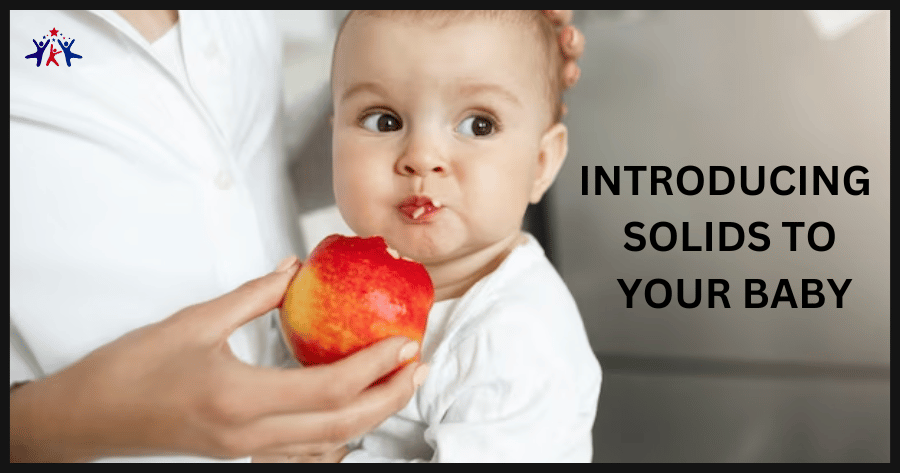Solids to your baby offer a crucial milestone in their development, marking the transition from exclusive breastfeeding or formula feeding to a diverse array of solid foods.
As your little one grows, it’s time to embark on a new culinary journey – introducing solids. But fear not, intrepid parents, for we’ve got you covered with tips and strategies to ensure a smooth and successful start to your baby’s solid adventure. So, let’s dive in and explore the scrumptious universe of solid foods, and help your baby take their first steps towards becoming a foodie!
The Right Time: When to Begin the Solids Journey
Your baby’s first solid food should be a joyous occasion. It’s a milestone in their development and a sign that they are growing more mature, healthy and independent. It also means that they are ready to start exploring the wide world of flavours! But when is the right time to introduce solids? The answer is it’s recommended that you wait until your baby is about 4 months old before starting them on solid foods.
Watch for Developmental Signs
Introducing solids is an important milestone, so it’s crucial to start when your baby is developmentally ready. Look for signs like sitting up with minimal support, showing interest in your food, and losing the tongue-thrust reflex. Most babies are ready for solids around six months of age, but always consult your pediatrician for personalized guidance.
Observe Your Baby’s Feeding Patterns
As your baby grows, their feeding patterns may change, indicating that they’re ready for something more substantial. If your little one starts demanding more frequent feedings or seems unsatisfied after their usual milk or formula intake, it may be time to introduce solids.
Assess Their Motor Skills
A crucial aspect of starting solids is your baby’s ability to control their head and neck movements. When your baby can hold their head steady and turn it from side to side, they’re likely ready to take on the challenge of solid foods
First Foods: Choosing the Best Solids to Start With
Single-ingredient Purees
Begin with single-ingredient purees to help your baby adjust to new flavors and textures. Good first foods include pureed fruits, vegetables, and single-grain cereals. Offer one new food at a time, and wait three to five days before introducing another to identify any potential allergies or sensitivities.
Iron-rich Foods
Babies need iron for healthy growth and development, so consider introducing iron-rich foods like fortified cereals, pureed meats, and legumes early on.
The Art of Feeding: Mastering the Techniques for a Successful Start
Start Small
When introducing solids, start with small amounts – about a teaspoon or two – and gradually increase the quantity as your baby becomes more comfortable with the new food.
Follow Your Baby’s Cues
Pay attention to your baby’s hunger and fullness cues. Offer solids when your baby is hungry but not too tired, and stop feeding when they show signs of fullness, like turning away or clamping their mouth shut.
Be Patient and Persistent
It’s normal for babies to be hesitant or even reject new foods initially. Be patient and keep offering the food multiple times, as it can take up to 15 tries before a baby accepts a new taste or texture.
Mixing It Up: Expanding Your Baby’s Palate
Introduce a Variety of Flavors and Textures
As your baby becomes more comfortable with solids, start introducing a wider variety of flavors and textures. This can help prevent picky eating and ensure your baby gets a well-rounded diet.
Combine Foods and Flavors
Once your baby has tried several single-ingredient foods, start combining them to create new flavors and textures. This can help your baby learn to enjoy a variety of tastes and make mealtime more exciting.
Navigating Challenges: Tackling Common Solids Roadblocks
Dealing with Gagging and Choking
Gagging is a natural reflex that helps babies learn to eat safely. However, it’s essential to know the difference between gagging and choking. Always supervise your baby during mealtime, and learn infant choking first aid to be prepared for emergencies.
Managing Food Allergies and Sensitivities
Introduce potential allergens like eggs, peanuts, and fish one at a time, and watch for signs of an allergic reaction, such as rash, vomiting, or difficulty breathing. Consult your pediatrician if you suspect a food allergy or sensitivity.
In conclusion, introducing solids to your baby is an exciting and rewarding journey that sets the stage for a lifetime of healthy eating habits. By following the tips and strategies outlined in this guide, you’ll be well-equipped to navigate the world of baby food and help your little one develop a love for a variety of flavors and textures. So, go forth and conquer the great solids adventure, and watch your baby blossom into a budding food enthusiast!
Frequently Asked Questions
- How often should I offer solids to my baby?
First, offer solids once a day, gradually increasing to two or three times daily as your baby becomes more comfortable with eating.
- Should I start with fruits or vegetables?
There’s no strict rule on whether to start with fruits or vegetables. The key is to offer a variety of flavors and textures to help your baby develop a well-rounded palate.
- Can I make my own baby food at home?
Absolutely! Homemade baby food can be cost-effective and allows you to control the ingredients. Just be sure to follow proper food safety guidelines and consult your pediatrician for guidance on age-appropriate foods and textures.
- When can I introduce finger foods?
Finger foods can be introduced once your baby has developed the fine motor skills needed for self-feeding, usually around 8-10 months. Start with soft, easy-to-grip foods like cooked vegetables, soft fruits, and small pieces of cheese.
- When should I introduce water to my baby?
You can start offering sips of water when your baby begins eating solids, but breast milk or formula should remain their primary source of hydration until 12 months of age.
- How can I tell if my baby is allergic to a new food?
Signs of a food allergy can include rash, hives, swelling, vomiting, diarrhea, or difficulty breathing. If you suspect a food allergy, stop offering the food and consult your pediatrician.
Author
-

Dr. Sajid is a highly respected and experienced pediatrician who specializes in treating children of all ages. With a background in medicine and a passion for working with kids, Dr. Sajid has dedicated his career to helping young patients lead healthy and happy lives. He is particularly skilled in treating common childhood illnesses and developmental issues, such as allergies, asthma, and behavioral problems. Dr. Sajid is known for his gentle and compassionate approach to working with kids, and he is committed to making each visit to the doctor a positive and comfortable experience for his patients. His expertise in the field of pediatrics, combined with his warm and caring demeanor, make Dr. Sajid an excellent choice for families in need of a trustworthy and skilled kids doctor.
Drsajid@gmail.com Dr Sajid


